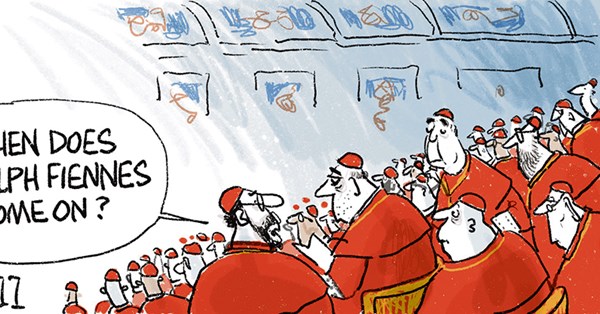AS THE cardinals gather in Rome to mourn and bid farewell to Pope Francis, the thoughts and minds of many Roman Catholics and others are naturally turning to the prospect of the papal conclave.
Conclaves have been a feature of papal history for about a millennium. The framework for them began when Nicholas II promulgated the papal bull In Nomine Domini, in 1059. This bull reserved, for the first time, the right to choose a papal successor exclusively to Rome’s clergy.
Various methods of selection had operated before then, including acclamation and nomination by the Byzantine Emperor, or his Holy Roman counterpart. Nicholas’s bull prohibited such involvement of laymen. The Pope was Christ’s representative on earth, he intimated: it was, therefore, essential that human agency be excluded from the process. The theory was that the Holy Spirit descended on the cardinals to inspire their choice. The Pope was not really their pick, but God’s: a circumstance that gave him an extraordinary mandate to claim unprecedented powers.
Conclave rules have evolved considerably since then. Many papal elections in the century after Nicholas were divisive affairs. Several 12th-century popes faced antipopes who disputed their election. In part, this was because the weight of cardinals’ votes was not consistent. Only from 1179, with Alexander III’s bull Licet de Vitanda, were all votes counted as equal: one cardinal, one vote. A two-thirds majority of those present was required for a candidate to claim election.
The rubrics surrounding the conclave’s organisational practices emerged slightly later than the voting regulations. Twelfth-century cardinals usually isolated themselves in one of the main ecclesiastical buildings near where the Pope had died. This was the best way to avoid secular interference in their deliberations.
LAYMEN’s impatience, however, led to many of the features that we now think of as characteristic of the conclave. In 1270, to remind the cardinals that the need for a pope was pressing, the citizens of Viterbo lifted the roof of the room in which they had gathered. Gregory X issued the bull Ubi Periculum, which set out normative prescriptions for conclaves (including that the cardinals be locked in “by key”, in Latin “cum clave”) shortly thereafter.
Gregory mandated that all cardinals sleep in the same dormitory and consume just one daily meal. That was the way to focus their minds. Of course, such prescriptions were honoured only in the breach during most later conclaves. Some conclaves were extremely long: that of 1314 lasted more than two years. Some 18th-century elections also lasted months.
Such conclaves were simultaneously spaces of great tedium and high drama. A dispute between cardinals in 1605 led some to strike their brethren (contemporary accounts report that their rochets became torn). In 1655, on the other hand, Cardinals Medici and Maidalchini were said to have been so bored that they made a bet that one of them could surprise a fellow cardinal by dressing up as the Holy Ghost and spooking him as he slept.
Ironically, we know far more about what happened in conclaves from 400 years ago than we do about those of recent times. Early-modern conclaves were very porous. Every Catholic prince and power wanted a view from the inside, and so hired agents or sent ambassadors in, disguised as cardinals’ assistants. This occasionally caused great scandal, as in 1550, when more than 400 men — eight times the number of actual cardinals — were found to be inside the sealed-off area.
Local Romans also kept their eyes peeled at all times for comings and goings. They evolved a lively market in conclave betting, which Gregory XIV prohibited only in 1591. That pope was not enthused to discover just how many books were being run about the moment when he himself would expire.
RECENT conclaves have been more sober and serious affairs. They have followed the same basic format of conclaves of centuries past (two votes per day, with plenty of time for prayer and discussion between them). But cardinals have been more respectful of their colleagues and of their obligations to remain tight-lipped.
The most recent conclave “scandal” occurred in 1903, when the Austrian government “vetoed” Cardinal Mariano Rampolla as a candidate: an act of outside interference, which had been in keeping with how conclaves had often operated during the Ancien Régime, but was unacceptable to the brave new world that had then developed.
Today, the cardinals reside for the conclave’s duration in the Domus Sanctae Marthae, the guesthouse in which Pope Francis himself lived. They cross over to the Sistine Chapel, home to all conclaves since the 19th century, for the day’s work.
The ritual of the black and white smoke, now an iconic feature of the conclave process, in fact also dates back only two centuries. It attests to the greater importance that modern cardinals have accorded the anxieties of the watching faithful.
At some point in the next two weeks — yes, I expect a short conclave: the cardinals know that the world’s eyes are on them — the senior cardinal will step forth on the balcony of St Peter’s. His words “Habemus papam!” will conclude, successfully, another round of one of the world’s longest-running electoral processes. As for who that pope will be? We will just have to wait.
Dr Miles Pattenden is a lecturer in the faculty of history in the University of Oxford. His books include Electing the Pope in Early Modern Italy, 1450-1700 (OUP).

















